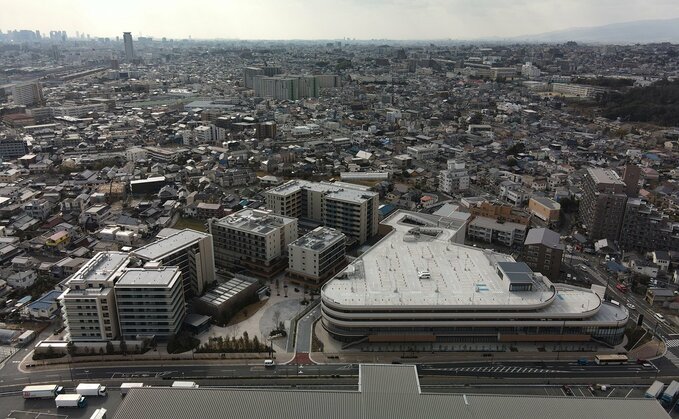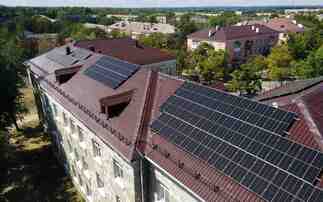
An arial view of the Suita smart town | Credit: Panasonic
Technology giant gives BusinessGreen a glimpse into how its purpose-built smart cities are solving multiple societal problems at once, from climate change to social isolation
In a northern suburb of Osaka, a brand new community development is aiming to be the first in Japan to derive all its electricity from renewable sources. The ‘smart town', officially opened in April, may not look radically different to the neighbourhoods that surround it, but it has been equipped with a number of cutting-edge technologies designed to boost connectivity, reduce emissions, and improve the wellbeing of its residents, ranging from green spaces, solar arrays, and electric vehicle (EV) infrastructure, to large energy storage systems that can provide up to three days of back-up power if a natural disaster strikes - which, in Japan, is quite often the case.
The development, which features more than 350 homes, boasts a wellness facility, a home for residents with dementia, a facility that provides home nursing services to the community, and a nursery school. It has been billed by Panasonic as a beacon of "multi-generational living".
For a long time the site of three factories owned by Japanese tech giant Panasonic, the Suita smart town is the latest development of a trio of smart town projects instigated and managed by the company and its partners. All three projects have seen the sites of Panasonic manufacturing plants transformed into ultra-modern, low-carbon ‘smart' developments, designed to have limited climate impacts while enhancing the wellbeing of their residents.
Panasonic's first town, Fujisawa, is some 50 kilometres south of Tokyo and has been fully operational since 2014. It is home to 600 households, with each residential home boasting solar panels on the roof and a plethora of smart technologies. Panasonic's second smart town, Tsunashima, meanwhile, opened in 2018 and provides a major technology hub, as the location for an Apple research and development centre, as well as homes, a shopping mall, a student dormitory, and a hydrogen refuelling station. Energy is carefully managed across the development to ensure optimal use of diverse energy sources, with an ‘Energy Centre' responsible for distributing electric power and heat to businesses and residents. A centralised IT platform visualises, monitors and optimises the town's energy and water use, ensuring that rain water is captured and reused.
Takeshi Arakawa, director of Panasonic's smart city promotion department, told BusinessGreen that smart cities' core purpose was to tackle social and community issues head on. Fujisawa, for instance, was designed with reducing traffic congestion in mind. Suita, on the other hand, aims to reduce loneliness and social isolation among the area's increasingly elderly population. As such, artificial intelligence-powered cameras, digital health programmes, and sensor-equipped dwellings have been installed specifically to assist older residents go about their daily lives, while the complex's wellness facility services have been plotted with the needs of older residents in mind.
But, like its two predecessors, Suita has also been designed to have limited climate impacts and prove as self-sufficient as possible. Solar panels, energy storage batteries, EV charging stations and car sharing infrastructure installed across the neighbourhood are designed to bring the region's energy consumption down, cutting costs for local businesses and residents.
A home hydrogen fuel cell system which uses fossil gas to generate electricity and heat for the "wellness complex" helps erode electricity demand further, by shuttling waste heat at times of low demand to single-person households. Meanwhile, all the electricity supplied to the community comes from clean power sources courtesy of a contract with Kansai Electric Power Company. The sourcing of clean power marks a significant step up from Fujisawa, which set out an aim - bold for the time - to cover more than 30 per cent of its electricity needs with renewable power.
Arakawa related that it made sense for Panasonic to invest in smart cities, given its broad portfolio of technology solutions. "We can take advantage of Panasonic's capability, products, and services to create the smart city concept which eventually helps to solve social, environmental and community problems," he said. "It is a good business model, because we can offer our services whilst also contributing to society. All the other corporations behind the schemes share exactly the same idea."
The Panasonic solutions that enable smart cities to come to life include housing solutions, IT and network related solutions, home electronic appliances, or energy-related solutions, he said. "We are packaging them together, based on the needs of each of the areas," he explained. "We aren't just offering these solutions one by one but offering them together."
However, Arakawa stressed that Panasonic's role in the three projects is not just as a landlord and service and technology provider, but also as a convenor of the various actors involved in each project. "We play a project manager and leader role," he said. "We know the regions well because we have operated factories there for a long time. We have a very strong relationship and communication with residents and the communities, and we also have a very strong relationship with administrators and local governments. That's why we play a very important role."
In each development, the town's management company provides energy, security, mobility, healthcare, and community services for the residents, which include blanket 24-7 CCTV coverage, smart sensor control of the LED street lighting, and access to EVs and bikes.
Collaboration is key to delivering a successful smart town or city, he said, noting that projects hinge on achieving a "tri-party balance" where the needs of government, communities, and companies are all considered in tandem. "Coordination is the key it will be to make this kind of concept successful," he said. The Suita smart town, for instance is a collaboration between more than a dozen companies and the local municipality,
It is critically important to actively incorporate feedback from the people who live in developments into smart town management, Arakawa added. "We need to put emphasis on the intentions or the hopes or ideas of residents and how we can take those [contributions] into the management of the scheme," he said. "So, in the case of Fujisawa, the management company enables residents to have direct communication with all these enterprises and the companies are providing services and products, so the companies gather a better understanding of their needs and desires."
Arakawa predicted that smart cities would crop up more and more in the future, both in Japan and further afield. "We have a lot of social issues and challenges to tackle, from urbanisation and ageing societies to environmental problems," he said. "The smart town or city approach is a very effective way to tackle these problems. That's why not only here in Japan, but also globally, we expect that kind of concept to be carried out more and more."
At any rate, smart cities are something of a testing ground for Panasonic to gauge how its products can be packaged together as integrated solutions, Arakawa revealed. "Hopefully in the future, we can roll out these packages to the other regions, and not only for just for smart cities but [as standalone] packages and integrated solutions."
Indeed, as fuel prices soar across Europe and parts of Asia, smart and integrated energy efficiency solutions are set to be increasingly sought after by savvy businesses and households looking to shield themselves from crippling energy bills. And as climate regulations on building developers become tighter, the market for holistic ‘smart' solutions that can boost the self-sufficiency of buildings could soar. Panasonic may be on to something.
This article was sponsored by Panasonic, a partner of the Net Zero Innovate Hub.









